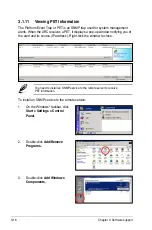
A-4
Appendix: Reference information
A.3
Converting decimal to hexadecimal
1. Divide the decimal number by 16 and you will get a quotient and a remainder.
2. Divide the quotient by 16 again to get another quotient and another
remainder.
3. Repeatedly divide the quotient by 16 until the quotient is 0.
4. Encoded all the remainders in the hexadecimal system.
Conversion table
Decimal
0 1 2 3 4 5 6 7 8 9 10 11 12 13 14 15
Hexadecimal
0 1 2 3 4 5 6 7 8 9 A B C D E F
5. The hexadecimal representation of your decimal number is the digit
sequence of all the remainders from the last to the first.
Here is an example of how to convert decimal to hexadecimal.
254 (in decimal)
1. When dividing 254 by 16, the quotient is 15 and the remainder is 14.
2. Divide the quotient 15 by 16 again to get the quotient 0 and the
remainder 15.
3. Refer to the table above and convert the remainders from decimal to
hexadecimal. The last (second) remainder is F (15 decimal). The second
last (first) remainder is E (14 decimal).
4. Write down the last (second) remainder in the most significant digit, and
the second last (first) remainder in the least (less) significant digit.
5. The hexadecimal expression of 254 is FE.
Содержание ASMB3-SOL
Страница 1: ...ASMB3 SOL PLUS Server Management Board ...
Страница 10: ... ...
Страница 70: ...A 6 Appendix Reference information ...



































